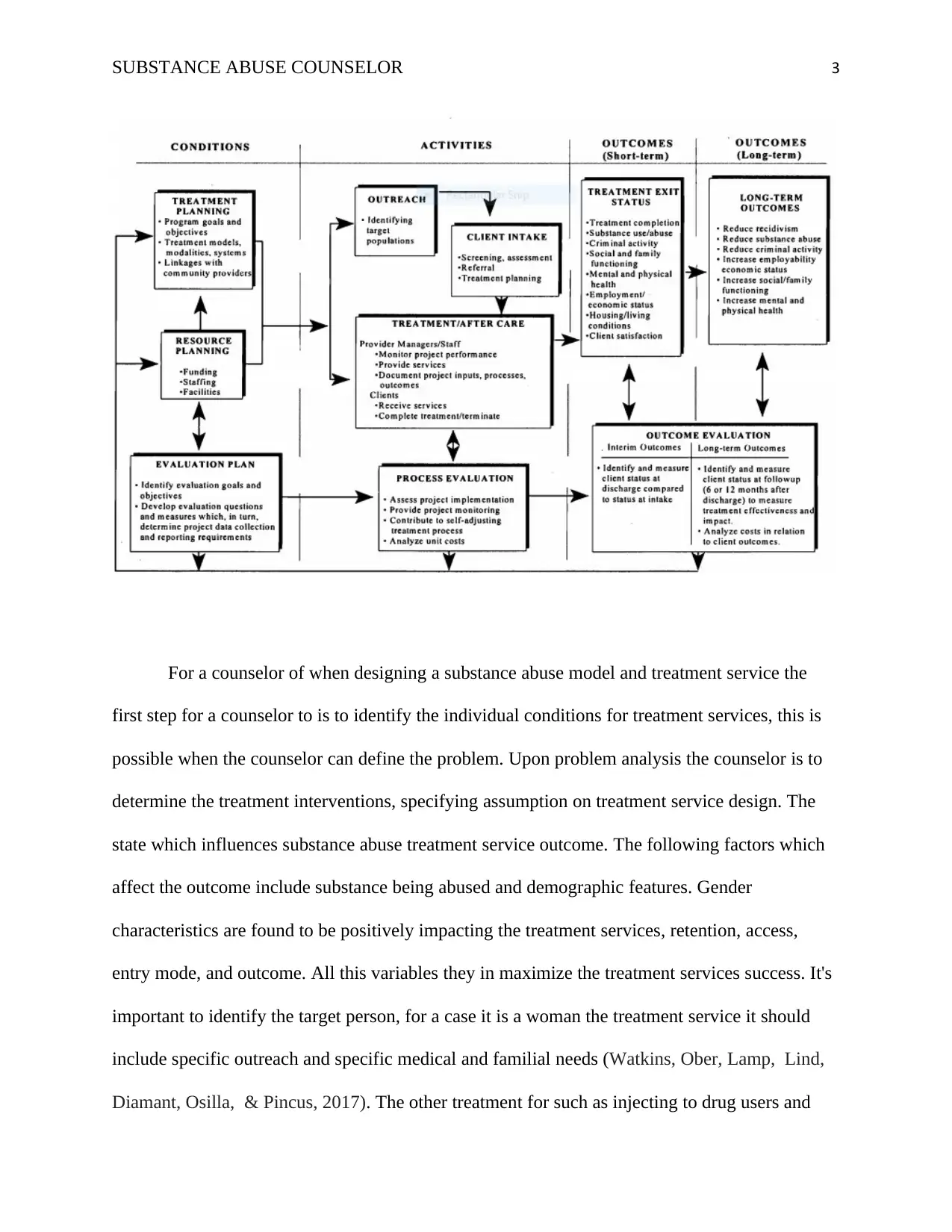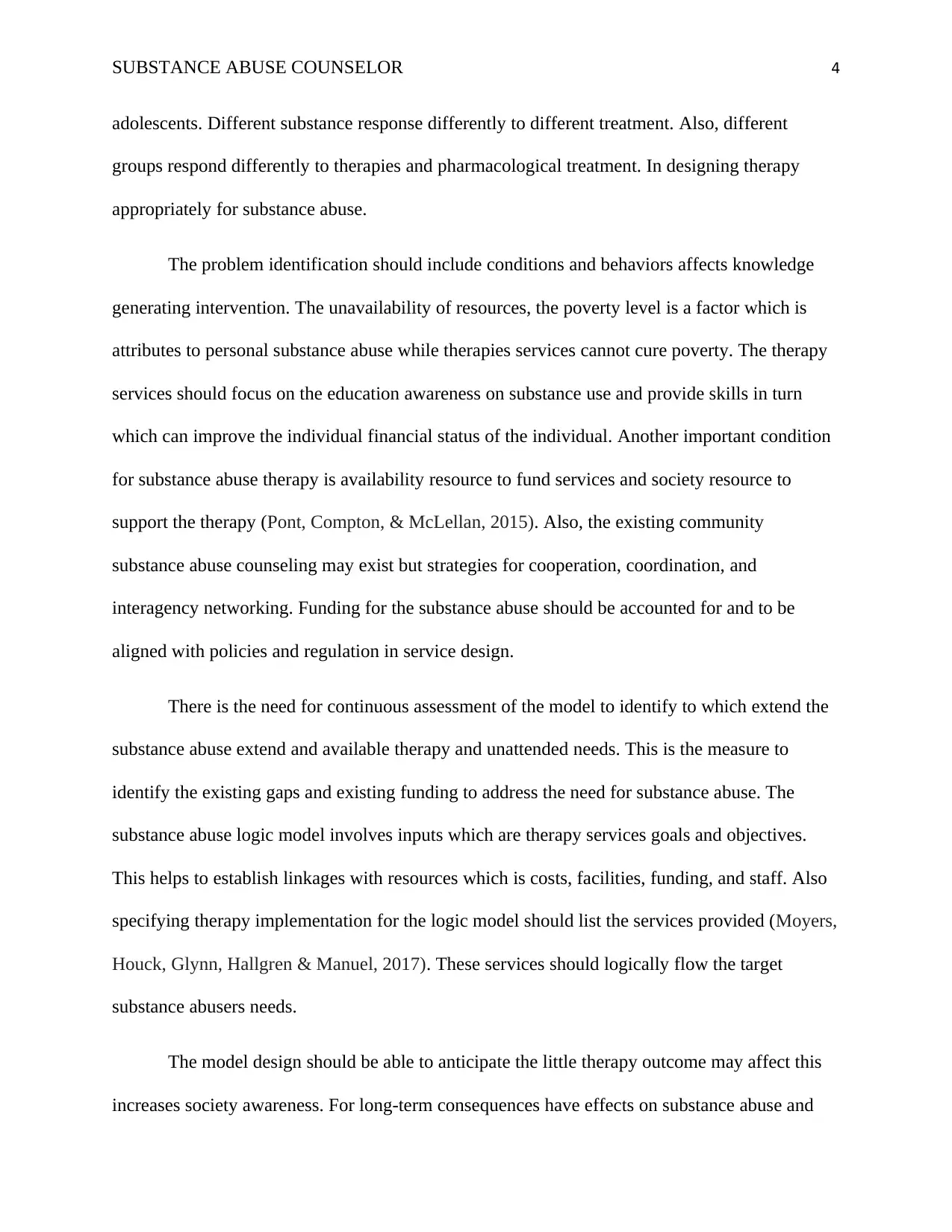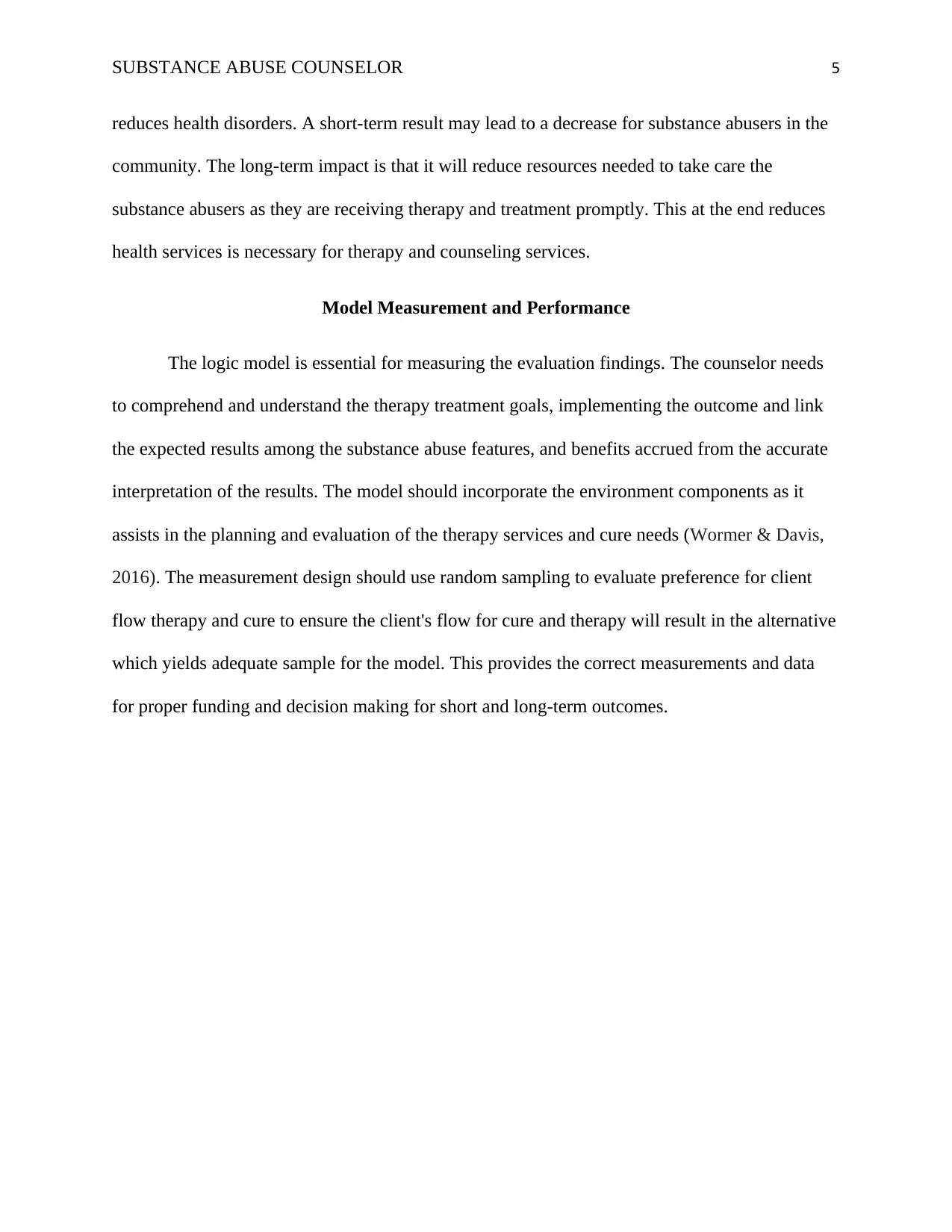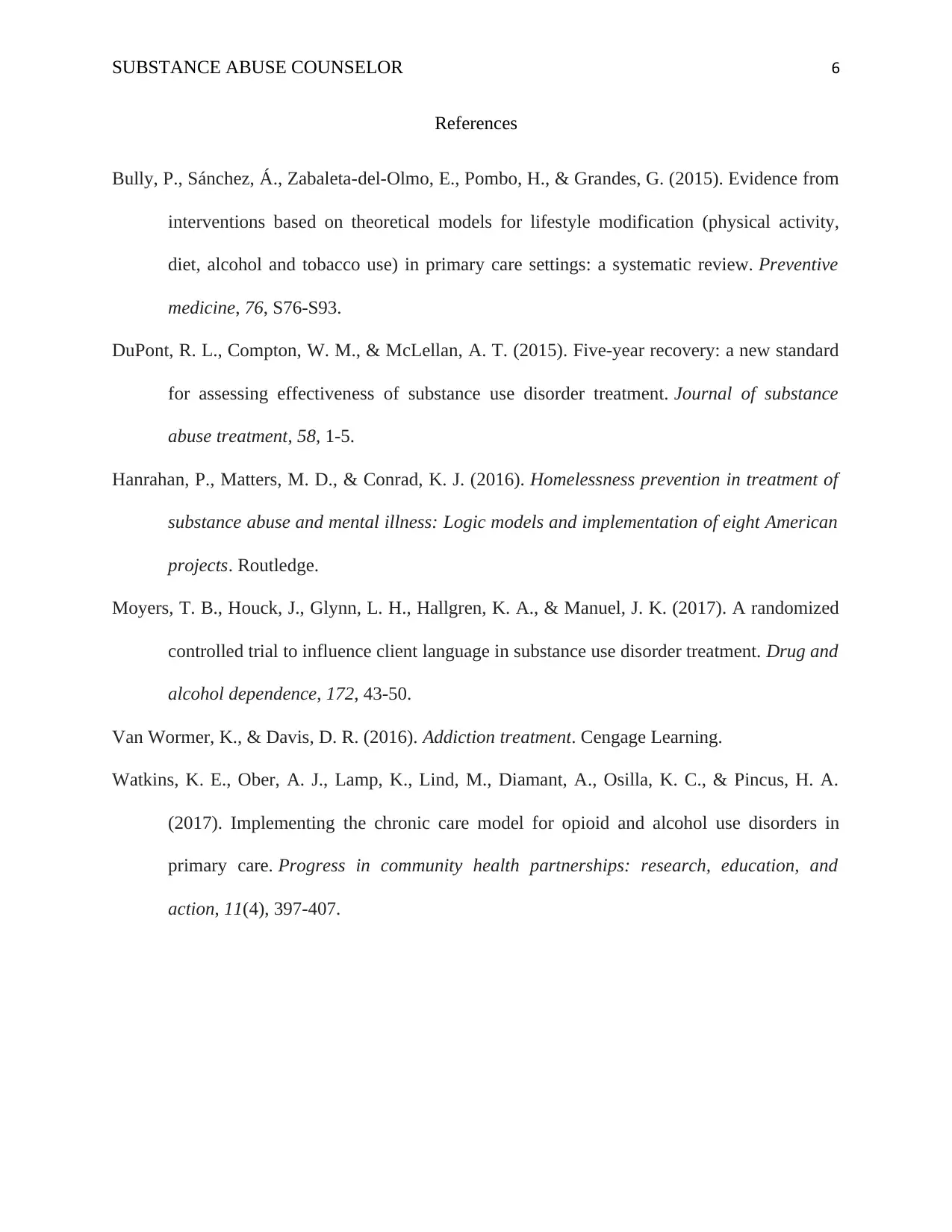Substance Abuse Counselor: Logic Model, Short & Long Term Effects
VerifiedAdded on 2023/06/05
|6
|1254
|411
Report
AI Summary
This report examines the crucial role of a substance abuse counselor and the application of a logic model in addressing substance abuse, particularly alcohol abuse, and its short and long-term effects on families. It outlines the steps involved in creating a logic model, from identifying individual conditions for treatment services and determining appropriate interventions to considering factors like demographics and resource availability that influence treatment outcomes. The report emphasizes the importance of problem analysis, setting therapy goals, and linking resources such as funding and staff to achieve desired outcomes, including increased societal awareness, reduced health disorders, and decreased substance abuse in the community. It also highlights the need for continuous assessment of the model to identify gaps and ensure alignment with policies and regulations. The measurement of the model's performance is essential for evaluating treatment goals and linking expected results to the benefits accrued from accurate interpretation, ultimately improving the effectiveness of therapy and counseling services.

Running head: SUBSTANCE ABUSE COUNSELOR 1
Substance Abuse Counselor
Student’s Name
Institutional Affiliation
Substance Abuse Counselor
Student’s Name
Institutional Affiliation
Paraphrase This Document
Need a fresh take? Get an instant paraphrase of this document with our AI Paraphraser

SUBSTANCE ABUSE COUNSELOR 2
Substance Abuse Counselor
Substance abuse involves intake of illegal drugs and also includes a large quantity intake
of drugs, alcohol, prescriptive medicine and taking legal drugs and substance for the wrong
purpose. For this reason, substance abuse has been a global health risk to human. According to
(Bully, Sánchez, Zabaleta, Pombo & Grandes, 2015) asserts that the continued demand for the
substance by individuals it leads to intolerance which means that one remains too long for more
of the drug or substance to satisfy needs. Heavy consumption of alcohol may result in alcoholism
which is the cause of reoccurrence substance disorder. This paper seeks to review the logic
model needed for substance abuse counselor in regards to alcohol abuse short and long-run
effects on family and the outcome.
Logic Model Needed For Substance Abuse Counselor
A logic model involves a series of steps which illustrates the rationale and assumptions
behind the human service program. A logic model for substance abuse allows the reader to
understand how counselor activities or plan for treatment planning, outreach, treatment exit and,
short-term outcome, long-term outcome and how these activities are to be achieved (Hanrahan,
Matters, & Conrad, 2016). It helps counselor to establish the link relationship between
stakeholders' needs, and transformation of inputs.
Substance Abuse Counselor
Substance abuse involves intake of illegal drugs and also includes a large quantity intake
of drugs, alcohol, prescriptive medicine and taking legal drugs and substance for the wrong
purpose. For this reason, substance abuse has been a global health risk to human. According to
(Bully, Sánchez, Zabaleta, Pombo & Grandes, 2015) asserts that the continued demand for the
substance by individuals it leads to intolerance which means that one remains too long for more
of the drug or substance to satisfy needs. Heavy consumption of alcohol may result in alcoholism
which is the cause of reoccurrence substance disorder. This paper seeks to review the logic
model needed for substance abuse counselor in regards to alcohol abuse short and long-run
effects on family and the outcome.
Logic Model Needed For Substance Abuse Counselor
A logic model involves a series of steps which illustrates the rationale and assumptions
behind the human service program. A logic model for substance abuse allows the reader to
understand how counselor activities or plan for treatment planning, outreach, treatment exit and,
short-term outcome, long-term outcome and how these activities are to be achieved (Hanrahan,
Matters, & Conrad, 2016). It helps counselor to establish the link relationship between
stakeholders' needs, and transformation of inputs.

SUBSTANCE ABUSE COUNSELOR 3
For a counselor of when designing a substance abuse model and treatment service the
first step for a counselor to is to identify the individual conditions for treatment services, this is
possible when the counselor can define the problem. Upon problem analysis the counselor is to
determine the treatment interventions, specifying assumption on treatment service design. The
state which influences substance abuse treatment service outcome. The following factors which
affect the outcome include substance being abused and demographic features. Gender
characteristics are found to be positively impacting the treatment services, retention, access,
entry mode, and outcome. All this variables they in maximize the treatment services success. It's
important to identify the target person, for a case it is a woman the treatment service it should
include specific outreach and specific medical and familial needs (Watkins, Ober, Lamp, Lind,
Diamant, Osilla, & Pincus, 2017). The other treatment for such as injecting to drug users and
For a counselor of when designing a substance abuse model and treatment service the
first step for a counselor to is to identify the individual conditions for treatment services, this is
possible when the counselor can define the problem. Upon problem analysis the counselor is to
determine the treatment interventions, specifying assumption on treatment service design. The
state which influences substance abuse treatment service outcome. The following factors which
affect the outcome include substance being abused and demographic features. Gender
characteristics are found to be positively impacting the treatment services, retention, access,
entry mode, and outcome. All this variables they in maximize the treatment services success. It's
important to identify the target person, for a case it is a woman the treatment service it should
include specific outreach and specific medical and familial needs (Watkins, Ober, Lamp, Lind,
Diamant, Osilla, & Pincus, 2017). The other treatment for such as injecting to drug users and
⊘ This is a preview!⊘
Do you want full access?
Subscribe today to unlock all pages.

Trusted by 1+ million students worldwide

SUBSTANCE ABUSE COUNSELOR 4
adolescents. Different substance response differently to different treatment. Also, different
groups respond differently to therapies and pharmacological treatment. In designing therapy
appropriately for substance abuse.
The problem identification should include conditions and behaviors affects knowledge
generating intervention. The unavailability of resources, the poverty level is a factor which is
attributes to personal substance abuse while therapies services cannot cure poverty. The therapy
services should focus on the education awareness on substance use and provide skills in turn
which can improve the individual financial status of the individual. Another important condition
for substance abuse therapy is availability resource to fund services and society resource to
support the therapy (Pont, Compton, & McLellan, 2015). Also, the existing community
substance abuse counseling may exist but strategies for cooperation, coordination, and
interagency networking. Funding for the substance abuse should be accounted for and to be
aligned with policies and regulation in service design.
There is the need for continuous assessment of the model to identify to which extend the
substance abuse extend and available therapy and unattended needs. This is the measure to
identify the existing gaps and existing funding to address the need for substance abuse. The
substance abuse logic model involves inputs which are therapy services goals and objectives.
This helps to establish linkages with resources which is costs, facilities, funding, and staff. Also
specifying therapy implementation for the logic model should list the services provided (Moyers,
Houck, Glynn, Hallgren & Manuel, 2017). These services should logically flow the target
substance abusers needs.
The model design should be able to anticipate the little therapy outcome may affect this
increases society awareness. For long-term consequences have effects on substance abuse and
adolescents. Different substance response differently to different treatment. Also, different
groups respond differently to therapies and pharmacological treatment. In designing therapy
appropriately for substance abuse.
The problem identification should include conditions and behaviors affects knowledge
generating intervention. The unavailability of resources, the poverty level is a factor which is
attributes to personal substance abuse while therapies services cannot cure poverty. The therapy
services should focus on the education awareness on substance use and provide skills in turn
which can improve the individual financial status of the individual. Another important condition
for substance abuse therapy is availability resource to fund services and society resource to
support the therapy (Pont, Compton, & McLellan, 2015). Also, the existing community
substance abuse counseling may exist but strategies for cooperation, coordination, and
interagency networking. Funding for the substance abuse should be accounted for and to be
aligned with policies and regulation in service design.
There is the need for continuous assessment of the model to identify to which extend the
substance abuse extend and available therapy and unattended needs. This is the measure to
identify the existing gaps and existing funding to address the need for substance abuse. The
substance abuse logic model involves inputs which are therapy services goals and objectives.
This helps to establish linkages with resources which is costs, facilities, funding, and staff. Also
specifying therapy implementation for the logic model should list the services provided (Moyers,
Houck, Glynn, Hallgren & Manuel, 2017). These services should logically flow the target
substance abusers needs.
The model design should be able to anticipate the little therapy outcome may affect this
increases society awareness. For long-term consequences have effects on substance abuse and
Paraphrase This Document
Need a fresh take? Get an instant paraphrase of this document with our AI Paraphraser

SUBSTANCE ABUSE COUNSELOR 5
reduces health disorders. A short-term result may lead to a decrease for substance abusers in the
community. The long-term impact is that it will reduce resources needed to take care the
substance abusers as they are receiving therapy and treatment promptly. This at the end reduces
health services is necessary for therapy and counseling services.
Model Measurement and Performance
The logic model is essential for measuring the evaluation findings. The counselor needs
to comprehend and understand the therapy treatment goals, implementing the outcome and link
the expected results among the substance abuse features, and benefits accrued from the accurate
interpretation of the results. The model should incorporate the environment components as it
assists in the planning and evaluation of the therapy services and cure needs (Wormer & Davis,
2016). The measurement design should use random sampling to evaluate preference for client
flow therapy and cure to ensure the client's flow for cure and therapy will result in the alternative
which yields adequate sample for the model. This provides the correct measurements and data
for proper funding and decision making for short and long-term outcomes.
reduces health disorders. A short-term result may lead to a decrease for substance abusers in the
community. The long-term impact is that it will reduce resources needed to take care the
substance abusers as they are receiving therapy and treatment promptly. This at the end reduces
health services is necessary for therapy and counseling services.
Model Measurement and Performance
The logic model is essential for measuring the evaluation findings. The counselor needs
to comprehend and understand the therapy treatment goals, implementing the outcome and link
the expected results among the substance abuse features, and benefits accrued from the accurate
interpretation of the results. The model should incorporate the environment components as it
assists in the planning and evaluation of the therapy services and cure needs (Wormer & Davis,
2016). The measurement design should use random sampling to evaluate preference for client
flow therapy and cure to ensure the client's flow for cure and therapy will result in the alternative
which yields adequate sample for the model. This provides the correct measurements and data
for proper funding and decision making for short and long-term outcomes.

SUBSTANCE ABUSE COUNSELOR 6
References
Bully, P., Sánchez, Á., Zabaleta-del-Olmo, E., Pombo, H., & Grandes, G. (2015). Evidence from
interventions based on theoretical models for lifestyle modification (physical activity,
diet, alcohol and tobacco use) in primary care settings: a systematic review. Preventive
medicine, 76, S76-S93.
DuPont, R. L., Compton, W. M., & McLellan, A. T. (2015). Five-year recovery: a new standard
for assessing effectiveness of substance use disorder treatment. Journal of substance
abuse treatment, 58, 1-5.
Hanrahan, P., Matters, M. D., & Conrad, K. J. (2016). Homelessness prevention in treatment of
substance abuse and mental illness: Logic models and implementation of eight American
projects. Routledge.
Moyers, T. B., Houck, J., Glynn, L. H., Hallgren, K. A., & Manuel, J. K. (2017). A randomized
controlled trial to influence client language in substance use disorder treatment. Drug and
alcohol dependence, 172, 43-50.
Van Wormer, K., & Davis, D. R. (2016). Addiction treatment. Cengage Learning.
Watkins, K. E., Ober, A. J., Lamp, K., Lind, M., Diamant, A., Osilla, K. C., & Pincus, H. A.
(2017). Implementing the chronic care model for opioid and alcohol use disorders in
primary care. Progress in community health partnerships: research, education, and
action, 11(4), 397-407.
References
Bully, P., Sánchez, Á., Zabaleta-del-Olmo, E., Pombo, H., & Grandes, G. (2015). Evidence from
interventions based on theoretical models for lifestyle modification (physical activity,
diet, alcohol and tobacco use) in primary care settings: a systematic review. Preventive
medicine, 76, S76-S93.
DuPont, R. L., Compton, W. M., & McLellan, A. T. (2015). Five-year recovery: a new standard
for assessing effectiveness of substance use disorder treatment. Journal of substance
abuse treatment, 58, 1-5.
Hanrahan, P., Matters, M. D., & Conrad, K. J. (2016). Homelessness prevention in treatment of
substance abuse and mental illness: Logic models and implementation of eight American
projects. Routledge.
Moyers, T. B., Houck, J., Glynn, L. H., Hallgren, K. A., & Manuel, J. K. (2017). A randomized
controlled trial to influence client language in substance use disorder treatment. Drug and
alcohol dependence, 172, 43-50.
Van Wormer, K., & Davis, D. R. (2016). Addiction treatment. Cengage Learning.
Watkins, K. E., Ober, A. J., Lamp, K., Lind, M., Diamant, A., Osilla, K. C., & Pincus, H. A.
(2017). Implementing the chronic care model for opioid and alcohol use disorders in
primary care. Progress in community health partnerships: research, education, and
action, 11(4), 397-407.
⊘ This is a preview!⊘
Do you want full access?
Subscribe today to unlock all pages.

Trusted by 1+ million students worldwide
1 out of 6
Related Documents
Your All-in-One AI-Powered Toolkit for Academic Success.
+13062052269
info@desklib.com
Available 24*7 on WhatsApp / Email
![[object Object]](/_next/static/media/star-bottom.7253800d.svg)
Unlock your academic potential
Copyright © 2020–2025 A2Z Services. All Rights Reserved. Developed and managed by ZUCOL.





